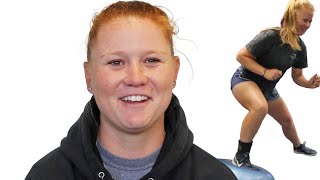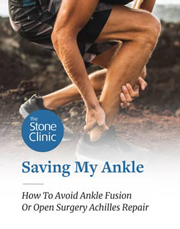Avoid a chronically unstable ankle with a BioAnkle® procedure
Hear From Our Patients
Ankle Ligament Instability Corrected for College Tennis Player
It’s a move that frequently leads to an ankle sprain and unfortunately, it happens all the time. An ankle sprain is one of the most common orthopedic injuries. You can sprain your ankle by just stepping off a curb badly. If the force is great enough, it will stretch your ligaments beyond their normal range, to a point where they tear. According to the American Academy of Orthopedic Surgeons, approximately 25,000 people sprain their ankle each day.
Most sprained ankles are minor. They get iced and taped and, after a while, they heal up. But in some cases, ankles don’t heal. That’s either because the ligaments were completely ruptured or the ankle became so unstable that the healing led to scar formation and a loose joint. These loose joints are sometimes tolerable, but often they can lead to instability, which interferes with a person’s daily activities or sports.
We see those loose joints in our clinic all the time. Fortunately, ankles that have failed to heal are repairable, most often by directly suturing the torn tissue and the surrounding structures in an outpatient procedure we have modified and improved over the years.
However, while it’s possible to repair a chronically unstable ankle, in my opinion, it is best to help people avoid ever getting to that unstable stage by making sure that simple torn ligaments are stimulated to heal properly in the first place.
Today, the science of tissue healing is expanding rapidly and very soon, I believe, most torn tissues, whether at the ankle, the elbow, the knee or the shoulder will receive an immediate treatment with a growth factor or stem cell derivative. These growth factors play a critical role in tissue formation and healing.
We have entered into what I call the anabolic orthopaedic era, where instead of removing or ignoring torn and damaged tissues, we will actively stimulate them to heal, immediately and rapidly dealing with the problem and avoiding the long-term instability that often occurs.
Currently, we are injecting the patients’ own growth factors into freshly torn tissues in a procedure called platelet-rich plasma. This is the first step in the optimizing process. Our lab is designing a new cell-loading technique, where we preload donor allograft tissues, such as meniscus or ligaments, with bioactive and growth factors. New variations and improved cell therapies are around the corner.
Remarkably, most of this research in our hands, and other research in labs, is working toward solutions that entirely bypass the giant pharmaceutical industry, the current driver of drugs and therapies. Instead, they tap into the body’s own natural resources, figuring out a way to augment healing. Stay tuned for this new era, where we use biologic solutions to fix injuries, solutions provided by you.
-


